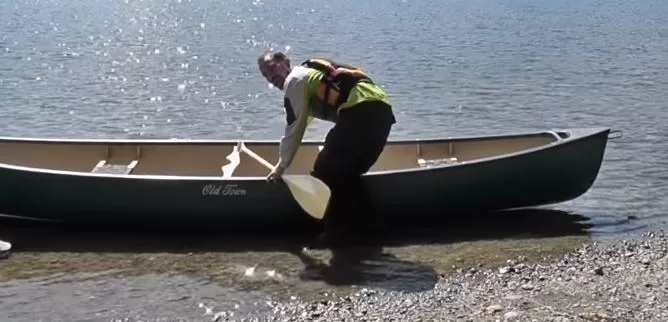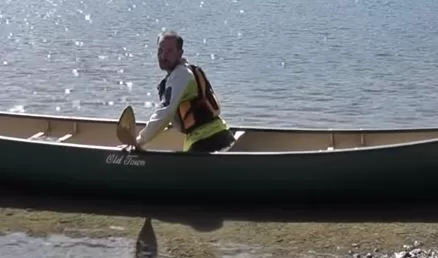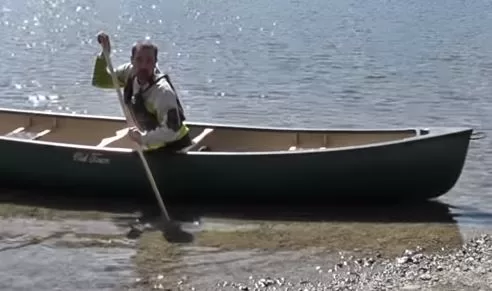Are you eager to embark on a thrilling canoeing journey, immersing yourself in the wonders of nature’s aquatic universe? If so, you’ve come to the right place! Today, we will unlock the secrets of launching a canoe – a skill that will serve as your ticket to unforgettable waterside escapades.
Whether you’re a novice paddler or looking to refresh your skills, mastering the basics of canoe launching is essential for a safe and enjoyable experience. From choosing the right spot to embark on your adventure to ensure a steady entry into the water, these simple steps will set you on the path to becoming a confident canoeist.
Let’s not waste more time and start our comprehensive guide on launching a canoe which includes all the minute details you need to consider.
Key Takeaways On Launching A Canoe
Where Can I Launch a Canoe – There are several suitable places to launch a canoe, including boat ramps, state parks, local marinas, beaches, etc.
Can a beginner safely launch a canoe safely – Knowing the right techniques and taking assistance from an experienced paddler, even a beginner can launch a canoe safely.
How to launch a canoe in a river, lake, ocean or anywhere – Lower the canoe in the waters, and hold its side gunnel with one hand for stability. Make sure the center of gravity is low when stepping inside, and also ensure even weight distribution.
How to Launch A Canoe – (Step-by-Step)
Although launching a canoe does not require any professional assistance, you still need to consider a few things for a safe operation. Here are some tested tips that can help you in the course:
- Lower canoe into the water
When lowering the watercraft in any water body, you must understand the right place to stand. Make sure you stay on the shore with a canoe placed parallel to the water.
It’s important to ensure the boat’s level remains intact when lowering it, and there shouldn’t be any abrupt movements to avoid tipping. Keep lowering it until the canoe is floating partially in the water. Also, it shouldn’t go too far and must be in your reach.

- Place hand on the gunnel, paddle in other
Finally, when the canoe is in the waters, you need to place your one hand on the gunnel’s side. This helps stabilize the equipment’s position in the moving waters. Similarly, you also need to grasp the paddle securely with your other hand.

- Keep your center of gravity low
Now when it’s your turn to step inside, be careful about maintaining a low gravity center. But why is it important? Because sudden shifts in weight can cause the boat to get imbalanced and lead to unfavorable circumstances.
All you need to do is keep your body low and close to the canoe to prevent this occurrence.
- Step into the canoe at the center, one leg at a time
As we discussed maintaining the gravity, it can be achieved by stepping one leg at a time into the watercraft. Make sure the first step is closest to the canoe’s center, and you must place it firmly on the floor for even weight distribution.

- Keep hands on gunnels for support
Also, when you are proceeding toward stepping inside the canoe, make sure your hands are on the gunnel for support. This way, the chances of the watercraft’s tipping would be minimal. And you can get inside steadily without losing your balance.
- Get into a kneeling position
For further safety, adapting a kneeling position inside the canoe can immensely help. It allows you to achieve a low gravity center – a major requirement for the watercraft’s stability.
However, it’s not necessary as you can even sit inside, but the level of balance would be a bit lower in this scenario.

- Push off from shore
Finally, when you have settled inside the canoe, it’s time for you to begin your journey. But before you start proper paddling, make sure to move aside from the shore. A gentle stroke on the canoe paddle can help you perform this step efficiently.

Preparation for Canoe Launching
Now that you have a clear idea about launching a canoe, let’s dig deeper into what preparations you need to make before it. Here are some key points to consider:
- Checking equipment and gear
Before embarking on a canoeing adventure, safety must be your top priority. Therefore, it’s important to double-check all gear and equipment to ensure a smooth and secure journey:
Life Jackets: Verify their condition and a proper fit for all riders, ensuring you have enough for everyone on board.
Paddles: Inspect this canoe component for damage and secure blade attachments, as they determine your canoe’s performance on the water.
Safety Equipment: Make sure you are carrying essential items such as a first aid kit, whistle, throw rope, water removal device, sunscreen, insect repellent, and ample food and water.
- Assessing weather and water conditions
A day before embarking on the journey, you need to check the weather forecast. It’s highly recommended to avoid performing this water sport when storms or strong winds are predicted. Similarly, assessing water conditions is equally crucial.
Make sure that you check for the issued advisories or warnings in the region regarding high tides or strong currents. Knowing about the weather conditions can also help you plan your outfit for the trip accordingly.
- Planning the route and destination
Although you can plan your route while canoeing itself, it’s recommended to choose it before starting the journey. For example, if you are a beginner, opting for the side with calm waters would be a great idea.
In contrast, an experienced paddler can choose to boat in high water levels for an added thrill. Other than this, you must decide the maximum distance you’d be traveling for a safe return.
Also, calculate the expected time you will be spending on water and tell that to your close ones. This way, if you don’t return on time due to any unfortunate mishap, at least someone will come to your rescue.
- Make sure that your canoe is properly down and in the water
Lastly, before boarding the canoe, make sure it’s properly down and submerged in the water. It can be assessed by just looking at the watercraft’s position after you lower it down. Failing to ensure this can lead to tipping accidents, and eventually severe injuries or drowning incidences.
Can one person easily launch the canoe?
Yes, a single person can launch a canoe with the right knowledge and technique. Just precise steps, practice, and physical effort are essential, especially with heavy canoes.
Where Can I Launch a Canoe?
Public boat ramps:
Canoe launching from public boat ramps is generally straightforward, as they are designed to accommodate various watercraft. The advantage lies in their accessibility and ample parking nearby. However, during peak times, you may experience some congestion and may need to wait for your turn to launch.
State parks:
Canoe launching at state parks offers a scenic and serene experience, surrounded by natural beauty. The challenge here may lie in steering the canoe through narrower water channels or dealing with shallow water near the shore. However, the opportunity to observe wildlife up close in their habitat makes it worthwhile.
Beaches and coastal regions:
Canoe launching from beaches or coastal regions opens up a world of exploration with diverse ecosystems and potential encounters with ocean tides. However, you should be mindful of surf conditions and potential waves, which can be challenging for launching and landing.
Remote or wilderness areas:
Canoeing in remote or wilderness areas offers unparalleled solitude and nature’s beauty. However, launching here requires careful planning, as there may be limited access points and a lack of facilities. You must be self-reliant and well-prepared for any challenges that may arise.
Rivers and streams:
Launching a canoe from rivers and streams can be exciting, but you need to be prepared for varying water levels, currents, and obstacles like rocks or fallen trees. Proper navigation skills are crucial to ensuring a safe and enjoyable journey.
When to launch a canoe?
Although you can launch a canoe anytime considering weather updates, spring is the season with the best water conditions.
Difference of Launching a Canoe from the Dock and a Shore
| Aspect | Launching from dock | Launching from shore |
| Accessibility | Easy access from a stable dock | May require wading into water |
| Stability | Generally more stable | Maybe less stable |
| Ease of entry/exit | Smooth entry and exit | May require stepping into water |
| Support | Dock provides additional support | No additional support |
| Obstacles | Fewer obstacles to navigate | May have shore-side obstacles |
| Water depth | Easy access to deeper water | Need to ensure sufficient depth |
| Movement of canoe | Canoe may move with dock motion | More control over canoe movement |
| Assistance | May require less assistance | May benefit from extra help |
| Launching position | Parallel | Perpendicular |
| Paddling direction | Any direction | Must be carefully aligned |
| Canoe size | Suitable for various sizes | Challenging for larger canoes |
How do I choose an appropriate launch site for my canoe (at shore)?
When launching a canoe, choosing an appropriate site for the task is one of the crucial requirements. Here, we share with you, a comprehensive guide that can assist you in the process:
Check for local regulations:
Make sure you have permission to use the launching site. Some areas implement strict rules regarding this, breaching, which can lead to legal fines.
Access and parking:
The launching site must have easy access to the water, along with a gentle slope leading to the shore. Moreover, you also need to ensure there’s a sufficient parking area nearby so you can conveniently load and unload your canoe.
Water depth:
On the shoreside, you need to ensure there’s enough water to launch the watercraft safely without it hitting the bottom. Paddling in shallow waters can damage the canoe hull.
Shore’s stability:
You also need to ensure the launch site has a stable footing i.e., the area shouldn’t be muddy or soft banks. In this slippery scenario, it can get challenging to lower the canoe inside the waters.
Other than this, choosing an appropriate launch site for your canoe also depends on the type of water bodies you plan to paddle on. Here are some considerations for different water bodies:
If stability is your concern and you want to ensure safety during canoe launching, then you can install DIY canoe stabilizers.
Lakes and Ponds:
Look for a sandy or gravelly shoreline with a gentle slope into the water. Avoid launching from areas with rocks, submerged debris, or dense vegetation that might impede your entry into the water. Additionally, choose a location away from boat traffic to launch safely.
Rivers:
Seek out gradual sloping banks with minimal obstructions. Look for calm areas with minimal currents, as launching from a fast-moving part of the river could be challenging and potentially makes canoeing dangerous.
Coastal Areas:
When launching from coastal areas or beaches, consider the tide and surf conditions. Choose a spot with a gentle slope and watch for waves and currents that might make launching difficult.
Marshes and Wetlands:
Seek designated launch points or shallow areas with easy access to the water. Avoid launching from sensitive habitats to minimize environmental impact.
Remote or Wilderness Areas:
In such areas, you may not find established launch sites. Look for clearings or open spaces along the shore to safely enter the water. Always prioritize Leave No Trace principles to preserve the wilderness.
Regardless of the water body, ensure there are no restrictions or permits required for launching your canoe. Prioritize safety and choose launch sites that offer easy access to the water and clear paths for launching and landing. Lastly, always check the weather conditions and be aware of any potential hazards to have a safe and enjoyable canoeing experience.
Safety considerations for avoiding embarrassment and capsizing
Here are some things to consider for optimizing your and the canoe’s safety while launching and paddling the canoe.
- The launch site should be stable, free of any debris or sharp rocks. Also, there should be no slipperiness to prevent accidental falls.
- Even weight distribution is a must to maintain the stability of the canoe. Make sure that both gear and passengers on the watercraft are positioned in a balanced manner to avoid tilting on one side.
- Avoid sudden movements while boarding the canoe and guide all the paddlers about it, as this can increase the capsizing risk.
- When getting inside the canoe, you can use a paddle or a long pole to anchor the watercraft to the bottom. In this way, the boat won’t drift away during the boarding process.
- Don’t overcrowd the canoe with too many people. Moreover, maintain your calm while launching. Panicking during the process can worsen things.
What are some common mistakes people make when canoe Launching?
Apparently, how to launch a canoe seems like an easier task. But of course, there are some things that, if not considered, can lead to bigger threats during the journey. These especially occur when the paddler is inexperienced, and include:
Launching the boat too quickly: Don’t rush while launching the watercraft as you may overlook critical safety steps while doing so. Similarly, failing to stabilize the canoe before stepping on it is also a huge mistake that can cause accidents.
Choosing an unsuitable launch site: If you choose to launch the watercraft from uneven terrain, the process of safely lowering it into the water can get hindered.
Not securing the gear: Whatever equipment you are carrying on the canoe must be secure at one side inside the boat. If not, the stuff may slide to the other side leading to sudden weight shifting, and eventually increased risks of capsizing.
Overloading the canoe: Every canoe comes with a specific canoe weight-holding capacity, which if exceeded can lead to instability in the waters.
Uneven weight distribution: If everyone on board stays on one side of the boat, it can tilt or even tip due to uneven weight distribution.
Not wearing life jackets: Every single paddler in a canoe should wear a life jacket or a personal floating device. Failing to do this can put the on-boarders’ safety at risk.
Is launching a canoe easier than kayak?
The ease of launch of both watercraft depends upon a few important factors, as discussed below.
Weight: If we consider this criterion, canoes are a bit on heavier side than kayaks. Therefore, lowering them down into the waters can be a hectic task. While kayaks don’t give much tough time.
Solo Launching: You can find many kayaks in the market that are designed for solo paddlers, having a smaller size. Pertaining to this, launching this watercraft alone would be more manageable as compared to launching heavy-weight canoes.
Stability: Canoes have a wider hull design than kayaks, contributing to better stability. With this, boarding the canoe and maintaining balance would be an easy feat, as compared to a kayak.
To conclude, kayaks are definitely easier to launch in water than canoes, all because of their lesser weight and small/compact size.
FAQs – How to launch a Canoe Properly
What to do if my canoe starts tipping over during the launch?
In this case, you can lean towards the opposite side to counterbalance the canoe. If it continues to tip, then it’s better to step out of the watercraft to prevent capsizing. Therefore, wearing a canoe lifejacket before embarking on the journey is crucial.
Where do I need a license/permit for launching a canoe?
In most cases, you do not need a license or permit for recreational canoeing on non-commercial waters. However, some exceptions apply, such as in national parks, state parks, navigable waterways, or for specific activities like fishing or hunting. Therefore, you must always check local regulations before canoe launching.
Can I launch my canoe alone or do I need assistance?
Although you can launch a canoe all alone, having assistance can make the process more secure, especially for heavier canoes.
Are there any restrictions on launching a canoe in certain areas?
Yes, you can not launch a canoe on private properties or areas that are declared environmentally sensitive zones.
Can I stand up in the canoe or do I need to kneel down while launching and paddling?
You must kneel down or sit in a canoe while launching and paddling it. Standing in the canoe can be risky leading to capsizing.
What do I need to do in windy or rough water conditions?
It’s recommended to check weather conditions before canoeing. However, in case of a sudden emergency, like strong winds or water currents, you can maintain stability while staying low and centered in the canoe.

Passionate freelance writer and certified boat captain, Sam brings his expertise to this pedal boating & Canoeing blog. With a knack for captivating storytelling and in-depth knowledge of boating regulations, he’s here to make your boating experience even more enjoyable and informed.
